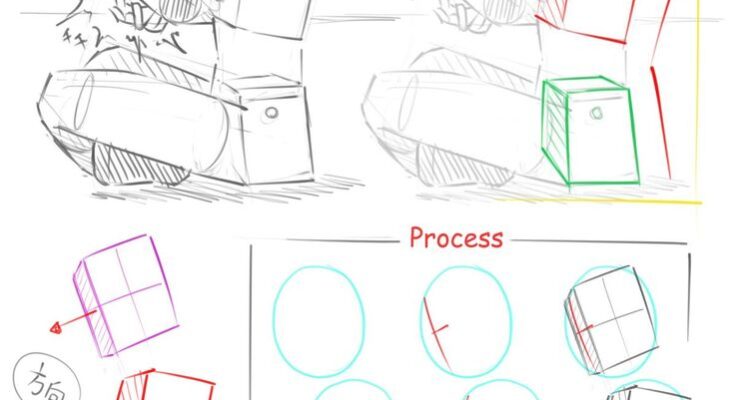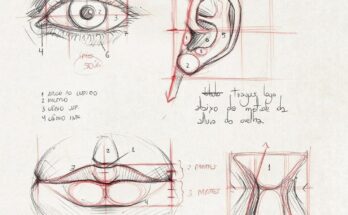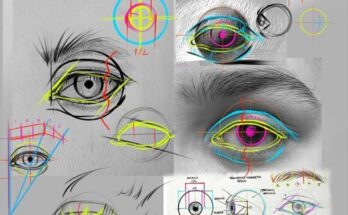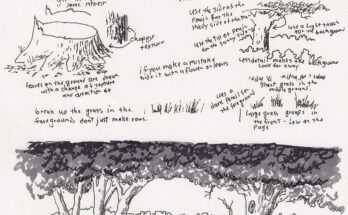Step-by-Step Tutorial on Drawing a Majestic Lighthouse: Structure, Texture, and Coastal Atmosphere for Maritime Illustration

Creating a majestic lighthouse is a rewarding pursuit for artists interested in maritime scenes, historical architecture, or atmospheric landscapes, blending structural precision with evocative environmental storytelling. This comprehensive tutorial is inspired by a reference sketch titled “Lighthouse,” which depicts a tall, cylindrical lighthouse perched on a rocky cliff, rendered in pencil with intricate detailing and soft shading. The image features a conical roof, a lantern room with glass panes, and a spiraling staircase visible through an open door, overlaid with red construction lines to guide perspective, structural proportions, and shadow placement. Annotations highlight key elements such as weathered stone texture, wave-eroded rocks, and a misty coastal backdrop, suggesting a dynamic interplay between the man-made structure and its rugged surroundings. The composition captures a timeless maritime mood, making it an excellent foundation for nautical art, travel illustrations, or game environments.
This guide is designed for intermediate artists, whether working traditionally with graphite on textured paper or digitally using tools like Procreate, Photoshop, or Krita, where layers can manage base sketches, textures, and effects. We’ll break it down into sections based on the reference: establishing perspective and base structure, detailing architectural features, adding coastal context, and applying atmospheric effects. Key techniques include mastering one-point perspective for depth, layering textures for stone and glass, and using value gradients to convey mood. This approach suits maritime history projects, fantasy coastal maps, or animated sequences, encouraging reference from real lighthouses (e.g., Portland Head Light) or coastal photography. Start with light sketching tools (e.g., H pencil or 20% opacity brush), a ruler for straight lines, and an eraser for adjustments, progressing to B pencils or opacity builds for shading. Given today’s date—11:14 AM +07 on Sunday, October 26, 2025—this tutorial aligns with a bright midday light setting in a time zone seven hours ahead of EDT, enhancing the lighthouse’s prominence against the sea.
Section 1: Establishing Perspective and Base Structure (Red Construction Lines)
The reference’s red lines provide a structural framework, capturing the lighthouse’s towering presence and balanced composition.
- Setting the Horizon Line and Vanishing Point: Draw a horizontal line across your canvas to represent the viewer’s eye level, placed midway (e.g., half the canvas height) to suggest a mid-level view. Choose a one-point perspective with a vanishing point centrally aligned along the lighthouse’s base, converging lines upward. The reference’s low-angle perspective enhances the structure’s height, so tilt the horizon slightly downward. Mark the vanishing point with a light dot.
- Blocking in the Base Structure: Sketch the lighthouse as a tall cylinder, tapering slightly toward the top, with a conical roof extending outward. Add a lantern room as a smaller cylinder atop the main body, with glass panes outlined as rectangles. The base sits on a rocky outcrop, drawn as an irregular polygon. Proportions: The lighthouse should dominate (about 60% of height), with the lantern room 10-15% of the total. Use light lines to outline the open door and spiraling staircase.
- Practical Tips: Use a ruler for precision in perspective lines. Common error: Uneven tapering—measure heights to maintain symmetry. Tip: Study lighthouse blueprints or photos for structural inspiration. Exercise: Draw a simple cylindrical tower with a conical roof, applying one-point perspective, then adjust for a slight tilt to match the reference’s dynamic angle.
This foundation ensures structural integrity, preventing distorted or flat appearances.
Section 2: Detailing Architectural Features (Lantern, Stairs, and Texture)
The reference’s pencil work focuses on texture and detail, bringing the lighthouse’s character to life.
- Lantern Room and Glass: Refine the lantern room with segmented glass panes, drawn as trapezoids converging toward the vanishing point. Add a metal framework with thin lines and a central light source (e.g., a small circle) for the beacon. The image shows reflections, so use light shading to suggest glass sheen.
- Spiraling Staircase: Detail the open door with an arched frame, revealing a spiraling staircase inside. Draw the steps as curved lines wrapping around a central pole, tapering as they ascend, aligned with perspective. The reference’s annotations suggest shadow emphasis, so plan light from above-right.
- Weathered Stone Texture: Add texture to the cylinder with horizontal lines for stone courses and vertical joints, denser near the base where erosion is implied. Include cracks or moss patches with irregular strokes. The image’s shading suggests age, so vary line weight—thicker for foreground, thinner for upper sections.
- Application Notes: Use a stump or soft brush to blend shadows for a weathered look. Avoid mistake: Uniform texture—add unique marks for character. Exercise: Detail a lantern segment with glass and stairs, then replicate on the tower body.
These elements build the lighthouse’s historical aesthetic, grounding it in maritime realism.
Section 3: Adding Coastal Context (Rocks, Waves, and Surroundings)
The reference integrates natural elements to frame the lighthouse, enhancing its narrative role.
- Rocky Outcrop and Waves: Sketch the base as a jagged polygon with rough edges, adding wave patterns as curved, overlapping lines crashing against the rocks. The image shows erosion, so include smoothed stones and spray flecks. Draw waves receding toward the horizon, aligning with perspective.
- Vegetation and Sky: Add sparse grass or seaweed clumps on the rocks, using quick ovals for foliage, and a faint sky with cloud wisps as irregular shapes. The reference’s misty effect softens edges, so blend with a light wash.
- Distant Horizon: Include a distant coastline or sea horizon as a thin line, lightest at the edge (e.g., light gray) and darker closer (mid-gray). The image suggests depth, so layer overlapping waves.
- Integration Tips: Use the lighthouse as the focal point, with wave lines leading toward it. Common pitfall: Overcrowding—limit vegetation to 15-20% of the base. Exercise: Draw a coastal strip (rocks, waves, horizon) separately, then integrate with your lighthouse base.
This context adds depth, turning a structure into a living seascape.
Section 4: Applying Atmospheric Effects and Final Touches
The reference’s shading and mist create a midday coastal ambiance, enhanced by 11:14 AM +07 lighting.
- Shading and Shadow Casting: Apply light-to-dark gradients on a Multiply layer—brightest on the lantern top (facing the light source), darkest under eaves and rock crevices. Use the above-right light implied in the image, casting shadows leftward. Add soft blending for stone shadows.
- Atmospheric Mist: Add a light gray wash or layer opacity (e.g., 10-15%) over distant elements (horizon, far waves) to suggest midday haze. The reference’s faint outlines indicate this, enhancing depth.
- Final Details: Refine with small touches—seagulls in the sky, faint window glows, or seaweed strands. The reference’s light shading hints at spray, so add subtle white flecks near waves.
- Critique and Adjustment: View the drawing inverted or grayscale to check value balance. Adjust mist or shadows if the lighthouse loses prominence.
Additional Professional Tips for Mastery
- Tools and Materials: 2H for outlines, 4B for shading; digitally, use custom texture brushes for stone. Carry a sketchbook for coastal studies.
- Common Challenges: Perspective errors—use a horizon guide. For atmospheric realism, study midday coastal photos or videos.
- Exercises and Resources: Weekly: 30-minute lighthouse sketches from different angles. Reference “Drawing Scenery: Landscapes and Seascapes” by Jack Hamm or online maritime architecture archives.
- Extensions: Add a keeper figure, vary weather (rain, fog), or depict a ship for narrative richness.
This tutorial transforms the reference into a practical roadmap, enabling you to craft a majestic lighthouse with confidence. Practice consistently, and explore variations like stormy scenes or night beacons in our related guides!



